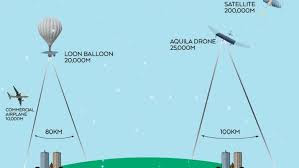170. It is impossible to see satellites with the naked eye as claimed
"People even claim to see satellites with their naked eyes, but this is ridiculous considering they are smaller than a bus and allegedly 100+ miles away; It is impossible to see anything so small that far away. Even using telescopes, no one claims to discern the shape of satellites but rather describes seeing passing moving lights, which could easily be any number of things from airplanes to drones to shooting stars or other unidentified flying objects."
More opinion from Dubay with nothing to back it up
You can see a flickering candle from 30 miles away. You can see starlight from millions of miles away (although flat earthers would of course dispute that source).
Here is an experiment that you can do to see what speed that drone or balloon would need to be travelling. Then you can judge whether that is likely.
First use one of the Satellite tracking tools to find an observable satellite from your location. Check that the satellite appears as predicted. This may take some time because of weather conditions like cloudy nights.
https://in-the-sky.org/satmap_worldmap.php
Once you have convinced yourself that the tool accurately predicts the appearance of satellites, look up the details of one of those satellites.
The details will contain the orbital period. I.e. the time it takes for the satellite to perform once circuit of the earth. Make a best guess as to the distance that the satellite would travel if the earth was flat. I’ll assume a VERY conservative 12450 miles, which I believe is the length of the circumference at the equator on a flat earth.
We can then work out what speed a drone would have to be travelling to mimic this particular satellite on a flat earth.
For example:
In Dallas on the 15th April 2018 between 5.58 and 6.06 the satellite SL16 R/B is visible. According to the details that the tool has for that satellite (The same details that it uses to successfully predict its appearance), the orbital period is 97 minutes.
To make a full circuit on a flat earth it would have to travel at 128 miles per minute, 985 miles per hour, which is 1.2 times the speed of sound.
That is a speed impossible for a balloon or for a drone that would need to stay aloft indefinitely.
Consider the fuel that would be required to keep a drone circling above a flat Earth at that speed. We simply do not have the technology that would allow us to do that. Solar power could not provide enough energy, and aircraft fuel would run out very quickly.
The only solution that makes sense is that it is a satellite that is in orbit and that the Earth is a sphere.
< Prev 161-170 Next >
More opinion from Dubay with nothing to back it up
It is impossible to see anything so small that far away
Dubay's assertion that it would be impossible to see the light reflected off something as small as a satellite is easily disproved because people have looked into how sensitive the human eye is, and it is very sensitive.You can see a flickering candle from 30 miles away. You can see starlight from millions of miles away (although flat earthers would of course dispute that source).
[The observed light] could easily be any number of things from airplanes to drones to shooting stars ...
Since anything mimicking a satellite needs to stay aloft indefinitely it would need to be a solar powered drone or a balloon.Here is an experiment that you can do to see what speed that drone or balloon would need to be travelling. Then you can judge whether that is likely.
First use one of the Satellite tracking tools to find an observable satellite from your location. Check that the satellite appears as predicted. This may take some time because of weather conditions like cloudy nights.
https://in-the-sky.org/satmap_worldmap.php
Once you have convinced yourself that the tool accurately predicts the appearance of satellites, look up the details of one of those satellites.
The details will contain the orbital period. I.e. the time it takes for the satellite to perform once circuit of the earth. Make a best guess as to the distance that the satellite would travel if the earth was flat. I’ll assume a VERY conservative 12450 miles, which I believe is the length of the circumference at the equator on a flat earth.
We can then work out what speed a drone would have to be travelling to mimic this particular satellite on a flat earth.
For example:
In Dallas on the 15th April 2018 between 5.58 and 6.06 the satellite SL16 R/B is visible. According to the details that the tool has for that satellite (The same details that it uses to successfully predict its appearance), the orbital period is 97 minutes.
To make a full circuit on a flat earth it would have to travel at 128 miles per minute, 985 miles per hour, which is 1.2 times the speed of sound.
That is a speed impossible for a balloon or for a drone that would need to stay aloft indefinitely.
Consider the fuel that would be required to keep a drone circling above a flat Earth at that speed. We simply do not have the technology that would allow us to do that. Solar power could not provide enough energy, and aircraft fuel would run out very quickly.
The only solution that makes sense is that it is a satellite that is in orbit and that the Earth is a sphere.
< Prev 161-170 Next >




Comments
Post a Comment